Spider plants, with their cascading foliage and air-purifying qualities, have become a staple in households and indoor gardens around the world.
These resilient and visually captivating plants, scientifically known as Chlorophytum comosum, are renowned for their ability to thrive in various environments. While the classic variegated spider plant is the most familiar to many, there is a fascinating array of spider plant varieties to discover and enjoy.
In this blog post, we will embark on a captivating journey through the diverse world of spider plants.
From the iconic striped leaves of the Variegatum to the unique characteristics of the Hawaiian and Mandarin varieties, we will explore the different types of spider plants and unravel the beauty within each one.
Whether you’re a seasoned plant enthusiast or just beginning your green thumb adventures, join us as we delve into the charming variations of these beloved houseplants.
All Types Of Spider Plant Explained
Hawaiian Spider Plant
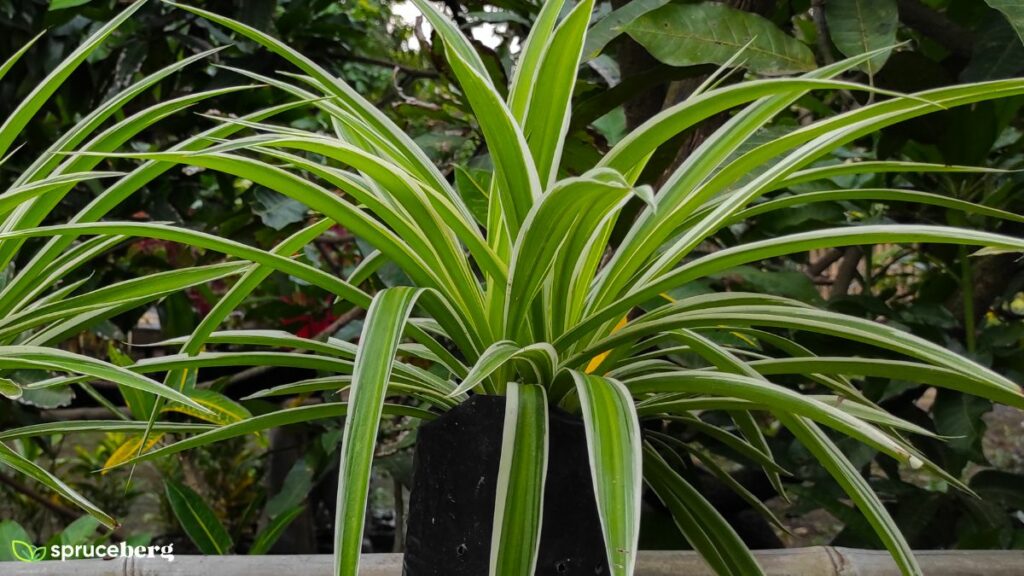
The Hawaiian Spider Plant, also known as Chlorophytum comosum ‘Hawaiian’ or Golden Glow, is a vibrant variety of spider plant that adds a touch of warmth and radiance to any space. With its unique foliage, this plant stands out among its counterparts.
The Hawaiian Spider Plant features leaves that have a vibrant yellowish-green color, giving them a golden glow. The center of each leaf has a narrow green stripe, creating an eye-catching contrast. This combination of colors gives the plant a cheerful and tropical appearance, reminiscent of the sunny Hawaiian islands.
Like other spider plant varieties, the Hawaiian Spider Plant is known for its air-purifying qualities, making it an excellent choice for improving indoor air quality. Its cascading foliage adds a decorative element to shelves, hanging baskets, or plant stands, bringing life and vibrancy to any room.
Caring for a Hawaiian Spider Plant is relatively easy, as it shares similar care requirements with other spider plant varieties. It thrives in well-draining soil and prefers moderate to bright indirect light. Watering should be done when the top inch of soil feels dry, and it appreciates moderate humidity levels.
Green Spider Plant
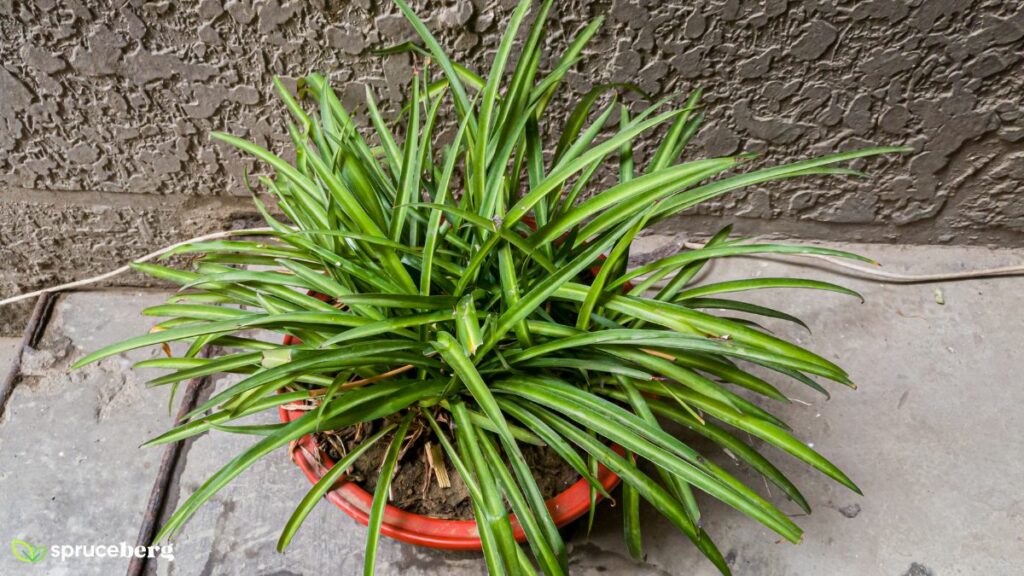
The Green Spider Plant, scientifically known as Chlorophytum comosum, is a classic and widely recognized variety of spider plant. It is celebrated for its lush green foliage and graceful cascading growth habit, making it a popular choice for indoor gardens and hanging baskets.
The Green Spider Plant is characterized by its long and arching leaves, which are a vibrant shade of green. The leaves are slender and pointed, creating an elegant and delicate appearance. This variety is known for its ability to produce numerous offshoots or “spiderettes” that dangle from the parent plant on long stems, giving it a cascading and visually appealing effect.
Not only is the Green Spider Plant aesthetically pleasing, but it also offers benefits for indoor environments. It is known to purify the air by removing harmful toxins and volatile organic compounds (VOCs), making it an excellent choice for enhancing indoor air quality.
When it comes to care, the Green Spider Plant is relatively low-maintenance. It thrives in bright, indirect light but can tolerate lower light conditions.
It prefers well-draining soil and should be watered when the top inch of soil feels dry. This plant appreciates moderate humidity levels, but it can adapt to a range of humidity conditions.
With proper care, green spider plant can grow bushier, giving it an attractive look.
With its beautiful green foliage and air-purifying properties, the Green Spider Plant is a versatile and enduring choice for both experienced plant enthusiasts and beginners alike. Its ability to thrive in various indoor settings, coupled with its graceful appearance, makes it a timeless and rewarding addition to any plant collection.
Zebra Spider Plant
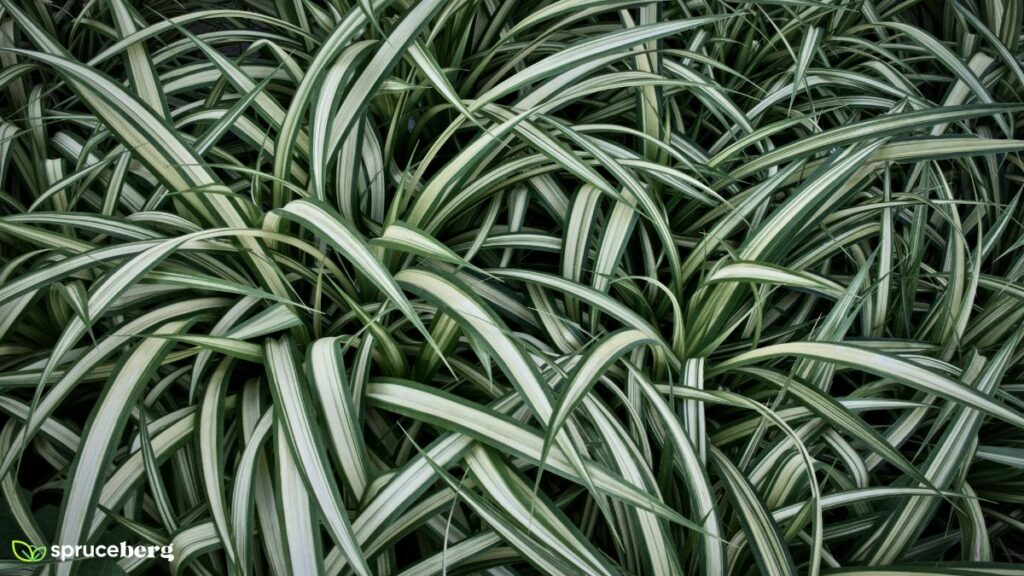
The Zebra Spider Plant, scientifically known as Chlorophytum comosum ‘Zebra’, is a stunning variety of spider plant distinguished by its striking striped leaves. This unique pattern resembles the black and white stripes of a zebra, hence its name.
The leaves of the Zebra Spider Plant are long and arching, with a dark green color and prominent white stripes running across them. The contrasting stripes create a visually captivating effect, adding a touch of boldness and elegance to the plant’s appearance.
Like other spider plant varieties, the Zebra Spider Plant is known for its air-purifying properties, making it an excellent choice for improving indoor air quality. Its cascading growth habit makes it a popular choice for hanging baskets or as a trailing plant on shelves and countertops.
Caring for a Zebra Spider Plant is relatively straightforward. It thrives in bright, indirect light but can tolerate lower light conditions. The plant prefers well-draining soil and should be watered when the top inch of soil feels dry. It appreciates moderate humidity levels, but it can adapt to various humidity conditions.
Propagation is another exciting aspect of the Zebra Spider Plant. It produces offshoots or “spiderettes” that can be separated from the parent plant and grown into new plants. This allows you to expand your spider plant collection or share the joy of growing with others.
Whether you’re seeking a visually striking plant to add interest to your indoor space or looking to benefit from its air-purifying qualities, the Zebra Spider Plant is a fantastic choice. Its unique striped leaves make it a captivating addition to any plant collection, bringing a touch of nature’s beauty into your home.
Curly Spider Plant
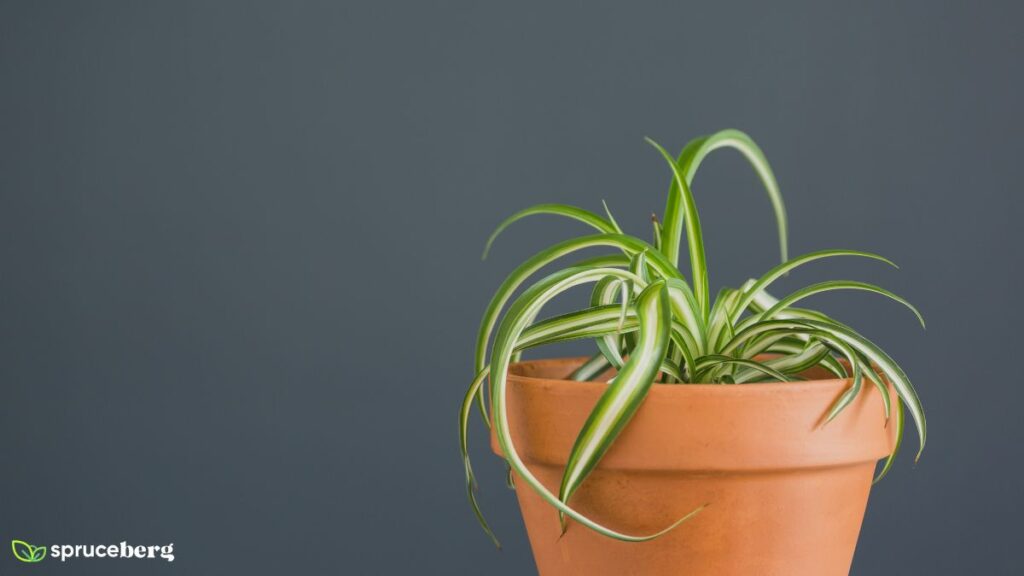
The Curly Spider Plant, scientifically known as Chlorophytum comosum ‘Bonnie’, is a captivating and distinct variety of spider plant that stands out for its curly leaves. This unique feature sets it apart from other spider plant varieties and adds a touch of whimsy and charm to any indoor setting.
The leaves of the Curly Spider Plant are characterized by their wavy and curly appearance. Unlike the straight and arching leaves of traditional spider plants, the leaves of the Curly Spider Plant have delightful twists and curls, creating a playful and dynamic look.
In terms of color, the leaves of the Curly Spider Plant are usually a vibrant shade of green. The curly texture enhances the plant’s visual appeal, adding texture and dimension to its overall appearance.
Like other spider plant varieties, the Curly Spider Plant is relatively easy to care for. It thrives in bright, indirect light but can tolerate lower light conditions. It prefers well-draining soil and should be watered when the top inch of soil feels dry. The plant appreciates moderate humidity levels, but it can adapt to different humidity conditions.
The Curly Spider Plant not only adds visual interest to your indoor space but also offers the air-purifying benefits associated with spider plants. It helps remove harmful toxins from the air, improving the overall air quality in your home or office environment.
Fire Flash Spider Plant

The Fire Flash Spider Plant, scientifically known as Chlorophytum comosum ‘Fire Flash’, is a captivating and vibrant variety of spider plant. It gets its name from the fiery reddish-orange coloration that adorns its foliage, adding a dramatic touch to its appearance.
The leaves of the Fire Flash Spider Plant exhibit a striking color gradient. They start with a rich green base and transition into vibrant shades of red or orange towards the tips, creating a fiery effect. This coloration gives the plant a unique and eye-catching look that sets it apart from other spider plant varieties.
In addition to its visually appealing qualities, the Fire Flash Spider Plant shares the air-purifying benefits associated with spider plants. It helps remove harmful toxins from the air, making it a valuable addition to any indoor environment.
Caring for the Fire Flash Spider Plant is similar to other spider plant varieties. It thrives in bright, indirect light but can tolerate lower light conditions. The plant prefers well-draining soil and should be watered when the top inch of soil feels dry. It can adapt to different humidity levels, but moderate humidity is generally beneficial.
The Fire Flash Spider Plant’s vibrant foliage makes it a striking choice for adding a pop of color to your indoor space. Whether placed on a tabletop, shelf, or hanging basket, its fiery leaves are sure to draw attention and create a visually stunning display.
Ocean Spider Plant
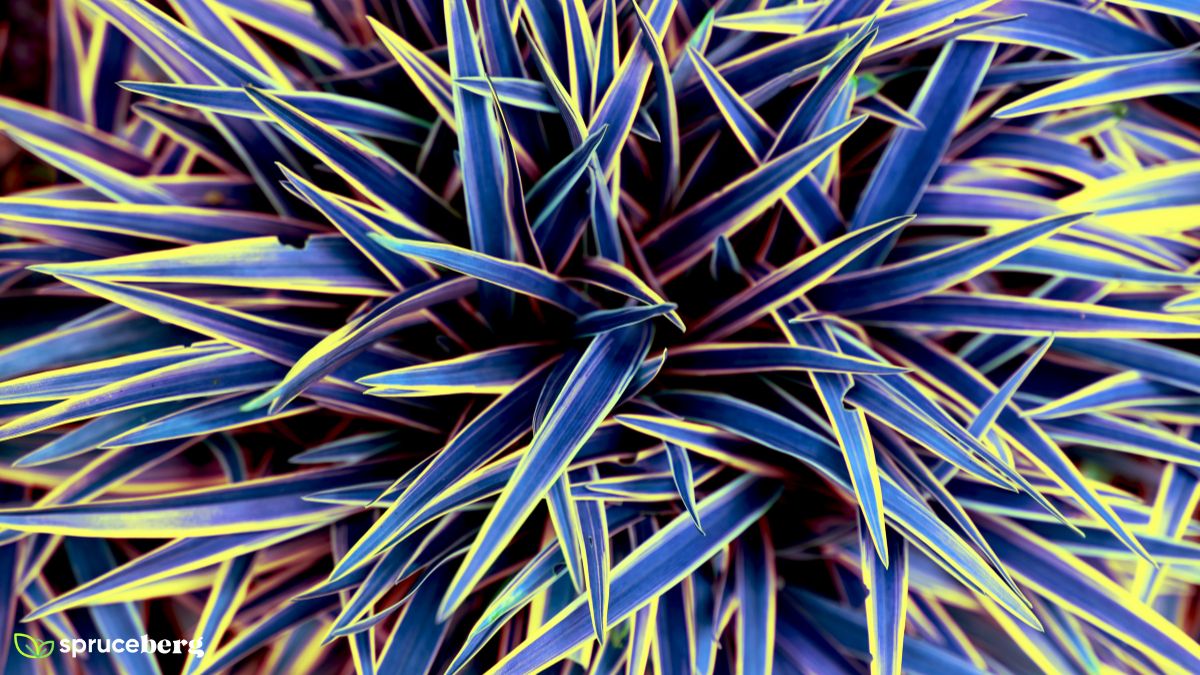
The Ocean Spider Plant is a unique cultivar within the Chlorophytum comosum species, known for its distinct foliage.
The leaves of the Ocean Spider Plant feature a vibrant green color with irregular creamy white or pale yellow stripes. The markings on the leaves resemble ocean waves or ripples, hence the name ‘Ocean.’ This variety adds a touch of visual interest and texture to indoor spaces.
Like other spider plant varieties, the Ocean Spider Plant is relatively easy to care for. It thrives in bright, indirect light but can tolerate lower light conditions. The plant prefers well-draining soil and should be watered when the top inch of soil feels dry. It can adapt to different humidity levels, making it suitable for various indoor environments.
The Ocean Spider Plant not only adds aesthetic appeal to your indoor space but also shares the air-purifying benefits associated with spider plants. It helps remove toxins from the air, contributing to a healthier living environment.
Chlorophytum Spider Plant
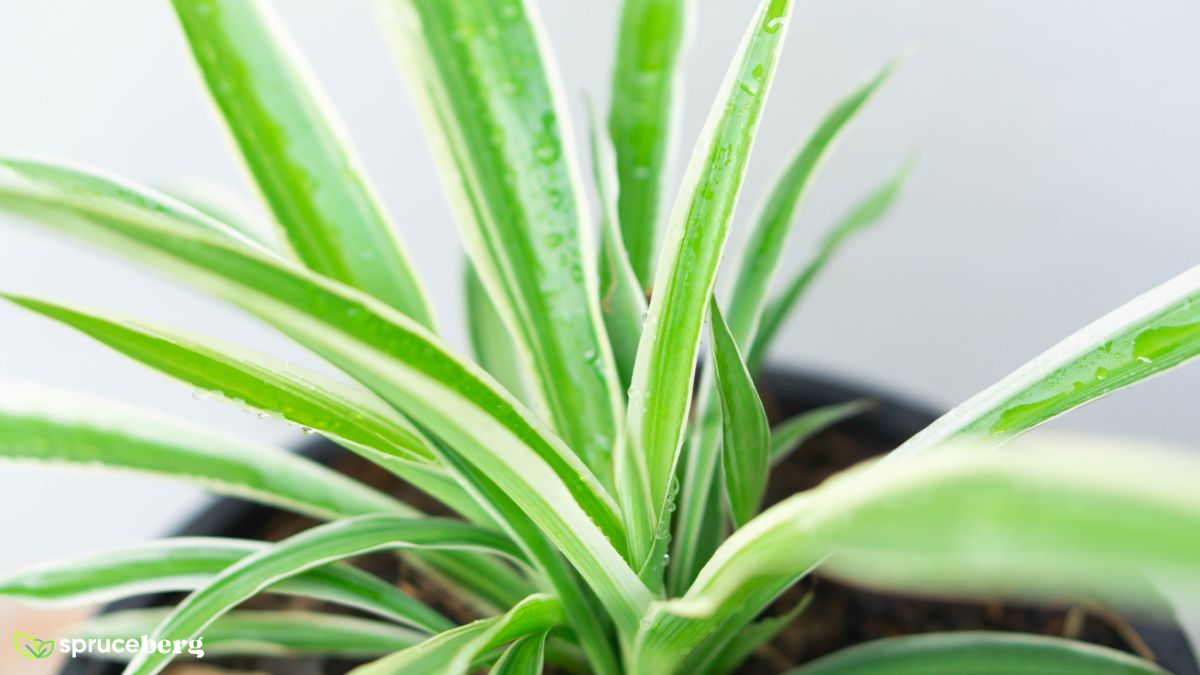
The Chlorophytum Spider Plant, scientifically known as Chlorophytum comosum, is a popular and well-known variety of spider plant. It is a versatile and resilient houseplant that is cherished for its cascading foliage and air-purifying properties.
The leaves of the Chlorophytum Spider Plant are long, slender, and arching. They are typically green in color, although some varieties may exhibit variegation with white or cream-colored stripes along the edges or in the center of the leaves. This variegation adds an extra visual appeal to the plant.
One of the remarkable features of the Chlorophytum Spider Plant is its ability to produce offshoots or “spiderettes” that grow from the parent plant. These spiderettes can be easily propagated and grown into new plants, allowing you to expand your spider plant collection or share them with others.
In addition to its aesthetic qualities, the Chlorophytum Spider Plant is known for its air-purifying abilities. It helps to remove harmful toxins from the air, making it a valuable addition to indoor environments and contributing to improved air quality.
Caring for the Chlorophytum Spider Plant is relatively easy, even for beginner plant enthusiasts. It prefers bright, indirect light but can tolerate lower light conditions. The plant should be watered when the top inch of soil feels dry, and it appreciates moderate humidity levels. With proper care, the Chlorophytum Spider Plant can thrive and bring beauty to your home or office space.
Overall, the Chlorophytum Spider Plant is a versatile and visually appealing houseplant that offers both aesthetic value and air-purifying benefits. Its cascading foliage and ease of care make it a popular choice for indoor gardens and a delightful addition to any plant lover’s collection.
Purple Spider Plant
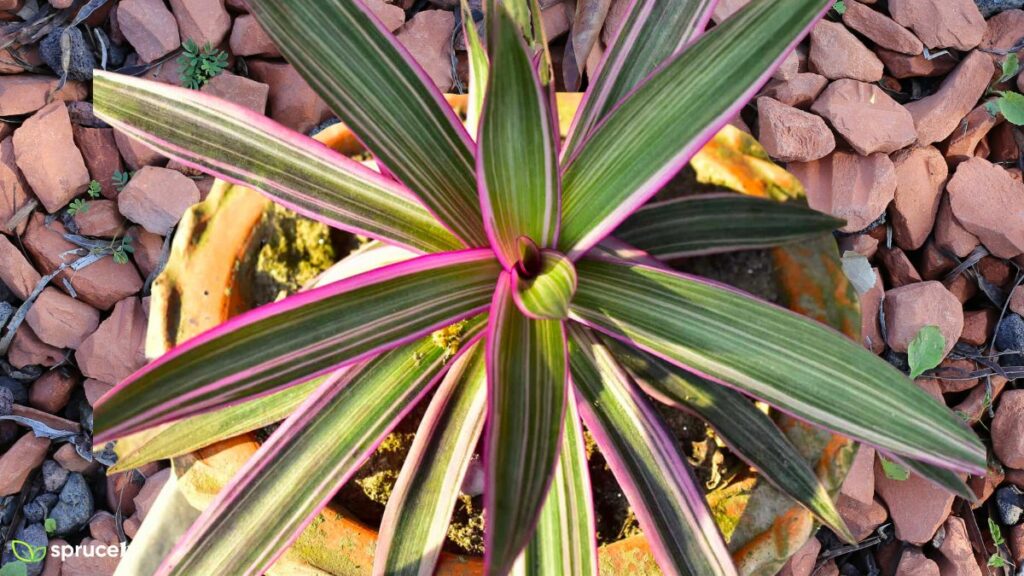
The Purple Spider Plant, also known as Chlorophytum comosum ‘Purple’ or ‘Purple Heart’, is a captivating and unique variety of spider plant. It stands out from other spider plant varieties due to its striking purple-hued foliage.
The leaves of the Purple Spider Plant display a rich purple coloration, creating a visually striking contrast. The vibrant purple hue adds a touch of drama and elegance to the plant’s appearance, making it a standout choice for those seeking a bold and eye-catching houseplant.
Similar to other spider plant varieties, the Purple Spider Plant is valued for its air-purifying properties. It helps remove harmful toxins from the air, contributing to a cleaner and healthier indoor environment.
Caring for the Purple Spider Plant is relatively straightforward. It thrives in bright, indirect light but can tolerate lower light conditions. The plant prefers well-draining soil and should be watered when the top inch of soil feels dry. It can adapt to different humidity levels, but moderate humidity is generally beneficial.
With its unique purple foliage and air-purifying qualities, the Purple Spider Plant adds a touch of color and freshness to any indoor space. Whether displayed on a tabletop, shelf, or as a hanging plant, its vibrant leaves are sure to make a statement and create an engaging visual display.
Shamrock Spider Plant
The Shamrock Spider Plant, scientifically known as Chlorophytum comosum ‘Shamrock’, is a unique and charming variety of spider plant. It is named after its foliage, which resembles the shape of a four-leaf clover or shamrock.
The leaves of the Shamrock Spider Plant are typically solid green and have a distinctive shape with three to four lobes, resembling the iconic symbol of luck, the shamrock. This unique leaf structure adds an interesting and decorative element to the plant’s overall appearance.
Like other spider plant varieties, the Shamrock Spider Plant is valued for its air-purifying properties. It helps remove toxins from the air, making it a beneficial addition to indoor environments and contributing to improved air quality.
Caring for the Shamrock Spider Plant is similar to other spider plant varieties. It prefers bright, indirect light but can tolerate lower light conditions. The plant should be watered when the top inch of soil feels dry, and it appreciates moderate humidity levels. With proper care, the Shamrock Spider Plant can thrive and bring a touch of luck and beauty to your home or office space.
The Shamrock Spider Plant is an excellent choice for those who appreciate unique foliage shapes and want to add a bit of whimsy and charm to their indoor garden. Whether displayed in a pot, hanging basket, or terrarium, its shamrock-like leaves create an eye-catching and delightful display.
Vittatum Spider Plant
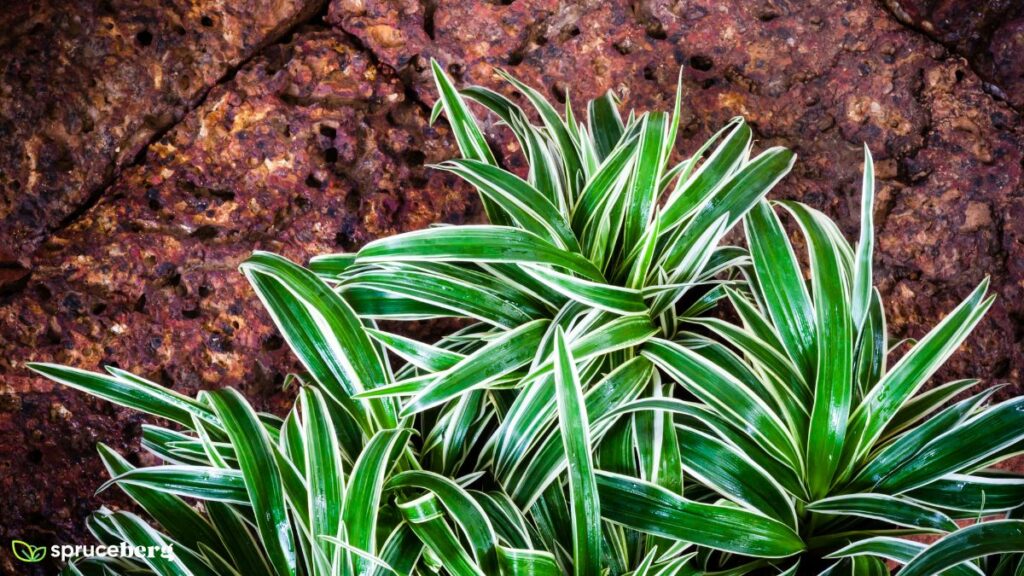
The Vittatum Spider Plant, scientifically known as Chlorophytum comosum ‘Vittatum’ or ‘Variegatum’, is one of the most well-known and widely recognized varieties of spider plant. It is cherished for its distinct and striking variegated foliage.
The leaves of the Vittatum Spider Plant are long and arching, with a vibrant green color. What sets this variety apart is the beautiful white or cream-colored stripes that run along the length of the leaves. The variegation creates a captivating contrast against the green background, giving the plant a unique and visually appealing appearance.
In addition to its aesthetic qualities, the Vittatum Spider Plant shares the air-purifying benefits associated with spider plants. It helps remove toxins from the air, making it a valuable addition to indoor environments and contributing to improved air quality.
Caring for the Vittatum Spider Plant is relatively easy, even for beginners. It thrives in bright, indirect light but can tolerate lower light conditions. The plant prefers well-draining soil and should be watered when the top inch of soil feels dry. It can adapt to different humidity levels, making it suitable for various indoor environments.
The Vittatum Spider Plant’s variegated foliage makes it a popular choice for adding visual interest and brightness to indoor spaces. Whether displayed in a pot, hanging basket, or as a trailing plant, its distinct leaves are sure to catch attention and create an attractive display.
Whether you’re an experienced plant enthusiast or just starting out, the Vittatum Spider Plant is a versatile and visually appealing choice. Its variegated foliage and air-purifying properties make it a delightful addition to any indoor garden or plant collection.
Variegated Spider Plant
The Variegated Spider Plant, scientifically known as Chlorophytum comosum ‘Variegatum’, is one of the most well-known and popular varieties of spider plant. It is cherished for its striking variegated foliage, which adds a touch of elegance and beauty to any indoor space.
The leaves of the Variegated Spider Plant are long, arching, and feature a vibrant green color. What makes this variety special is the presence of creamy white or yellowish stripes that run along the length of the leaves. The variegation creates a captivating contrast against the green background, giving the plant a visually appealing and eye-catching appearance.
In addition to its aesthetic qualities, the Variegated Spider Plant shares the air-purifying benefits associated with spider plants. It helps remove toxins from the air, making it a valuable addition to indoor environments and contributing to improved air quality.
Caring for the Variegated Spider Plant is relatively straightforward, making it suitable for both experienced plant enthusiasts and beginners. It thrives in bright, indirect light but can tolerate lower light conditions. The plant prefers well-draining soil and should be watered when the top inch of soil feels dry. It can adapt to different humidity levels, making it versatile for various indoor environments.
The Variegated Spider Plant’s variegated foliage makes it a popular choice for adding visual interest and brightness to indoor spaces. Whether displayed in a pot, hanging basket, or used as a trailing plant, its distinct leaves are sure to catch attention and create an attractive and lively display.
The Variegated Spider Plant is a versatile and visually appealing variety. Its variegated foliage and air-purifying properties make it a delightful addition to any indoor garden, providing both beauty and benefits to your living space.
Variegated Bonnie Spider Plant
The Variegated Bonnie Spider Plant, scientifically known as Chlorophytum comosum ‘Bonnie Variegatum’, is a unique and charming variety of spider plant. It is a variation of the standard Bonnie Spider Plant, featuring beautiful variegation on its foliage.
The leaves of the Variegated Bonnie Spider Plant have a distinctive curly shape, adding a whimsical touch to its appearance. The variegation on the leaves is characterized by creamy white or yellowish stripes that contrast with the vibrant green color of the foliage. This variegation enhances the overall visual appeal of the plant, making it an eye-catching addition to any indoor space.
Similar to other spider plant varieties, the Variegated Bonnie Spider Plant is valued for its air-purifying properties. It helps remove toxins from the air, contributing to a healthier indoor environment.
Caring for the Variegated Bonnie Spider Plant is relatively easy. It thrives in bright, indirect light but can tolerate lower light conditions. The plant prefers well-draining soil and should be watered when the top inch of soil feels dry. It can adapt to different humidity levels, making it suitable for various indoor environments.
The Variegated Bonnie Spider Plant’s curly leaves and variegated foliage make it a delightful choice for adding visual interest and liveliness to indoor gardens. Whether displayed in a pot, hanging basket, or used as a trailing plant, its unique characteristics are sure to draw attention and create an enchanting display.
Mandarin Orange Spider Plant
Chlorophytum amaniense is a species of spider plant that is native to the Amani Forest in Tanzania, East Africa. It is a less commonly known species compared to the widely cultivated Chlorophytum comosum.
Chlorophytum amaniense features broader and thicker leaves compared to its relatives, with a glossy green color. The leaves have a slightly arching growth habit and can reach a considerable length. This species tends to have fewer offsets or spiderettes compared to Chlorophytum comosum.
In terms of care, Chlorophytum amaniense is typically grown as a houseplant. It thrives in bright, indirect light and prefers well-draining soil. The plant should be watered when the top inch of soil feels dry. Like other spider plants, Chlorophytum amaniense is generally adaptable and can tolerate a range of humidity levels.
Due to its less widespread availability and specific habitat requirements, Chlorophytum amaniense may be more challenging to find compared to the more common varieties of spider plants. However, it can be a fascinating addition to a plant collection for those seeking something unique and less commonly seen.
Spider Flower Plant
The Spider Flower Plant typically refers to the Cleome genus, which includes several species of flowering plants known for their distinctive spider-like flowers. Cleome plants are native to various regions, including South America, Africa, and Asia.
The Spider Flower Plant is recognized for its clusters of vibrant flowers that have long, delicate petals resembling spider legs. The flowers can come in different colors such as pink, purple, white, or a combination of hues. The blooms are often fragrant and attract pollinators like bees and butterflies.
Cleome plants are annuals or perennials, depending on the species, and they typically grow tall with branching stems and attractive palmate leaves. They are commonly found in gardens and are popular for their unique and eye-catching floral display.
Caring for Spider Flower Plants usually involves providing them with well-drained soil and a location that receives full sun or partial shade. Adequate watering and occasional fertilization can help them thrive. Additionally, deadheading spent flowers can encourage more blooms.
Spider Flower Plants can be a wonderful addition to garden borders, flower beds, or containers, adding a touch of whimsy and color to the landscape. Their distinctive spider-like flowers make them stand out among other flowering plants, creating an interesting focal point in any outdoor space.
Reverse Variegatum Spider Plant
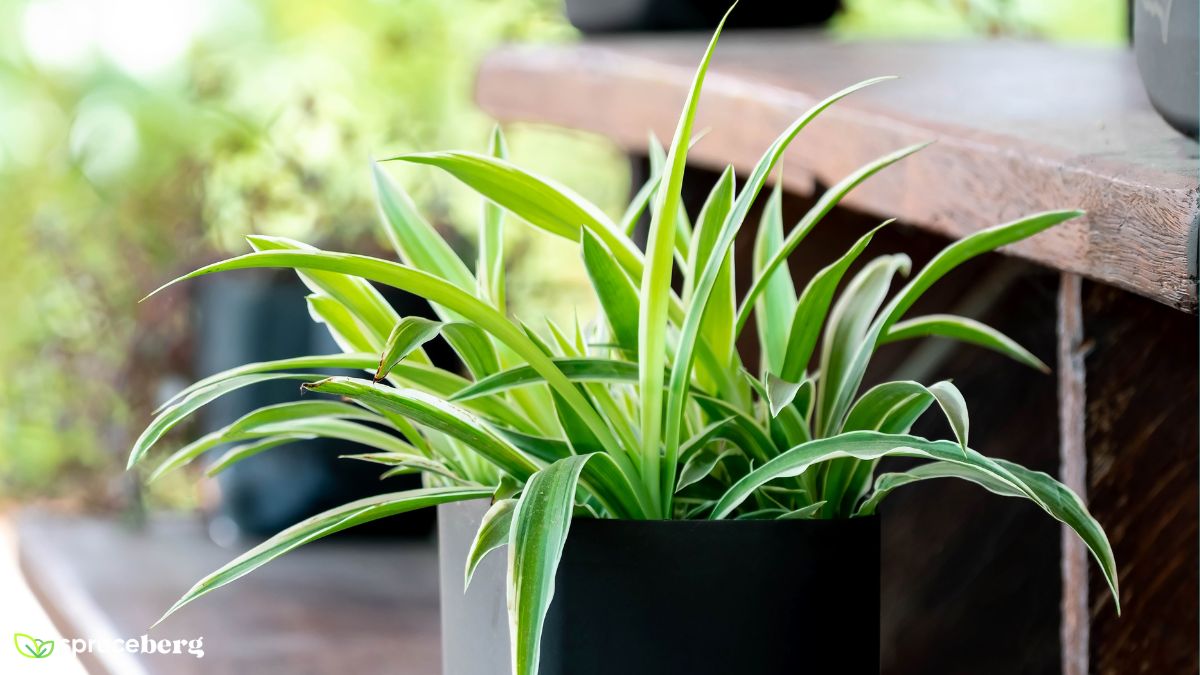
The Reverse Variegatum Spider Plant, scientifically known as Chlorophytum comosum ‘Reverse Variegatum’, is a unique and intriguing variety of spider plant. It is named for its reversed variegation pattern, which distinguishes it from the standard variegated spider plant.
While the leaves of the standard variegated spider plant have green stripes on a white or creamy background, the Reverse Variegatum Spider Plant showcases white or creamy stripes on a green background. This reversal of colors creates a captivating and distinct appearance, adding a touch of elegance and visual interest to the plant.
Like other spider plant varieties, the Reverse Variegatum Spider Plant is known for its air-purifying properties. It helps remove toxins from the air, making it a beneficial addition to indoor environments and contributing to improved air quality.
Caring for the Reverse Variegatum Spider Plant is similar to other spider plant varieties. It thrives in bright, indirect light but can tolerate lower light conditions. The plant prefers well-draining soil and should be watered when the top inch of soil feels dry. It can adapt to different humidity levels, making it suitable for various indoor environments.
The Reverse Variegatum Spider Plant’s reversed variegation pattern makes it an attractive choice for adding visual interest and diversity to indoor spaces. Whether displayed in a pot, hanging basket, or used as a trailing plant, its unique characteristics are sure to catch attention and create an engaging and elegant display.
Airplane Spider Plant
The Airplane Spider Plant, scientifically known as Chlorophytum comosum ‘Airplane’, is a unique and fascinating variety of spider plant. It gets its name from the distinctive shape of its leaves, which resemble tiny airplanes or propellers.
The leaves of the Airplane Spider Plant are elongated and have a narrow, curving shape that gives them the appearance of miniature airplanes. This distinctive leaf structure sets it apart from other spider plant varieties and adds a playful and whimsical element to its overall aesthetic.
Similar to other spider plant varieties, the Airplane Spider Plant is renowned for its air-purifying properties. It helps remove toxins from the air, contributing to improved indoor air quality and creating a healthier living environment.
Once you’ve found the perfect Spider Plant to bring home, it’s essential to know how to care for it properly. That’s why we’ve prepared a an article dedicated to “How to Prune Spider Plants.”
Wrap Up
In conclusion, spider plants offer a wide variety of captivating options to suit every plant lover’s taste. From the classic variegated varieties like Vittatum and Reverse Variegatum to the unique and whimsical options such as the Curly Spider Plant and Shamrock Spider Plant, each type brings its own charm and visual appeal.
Spider plants not only beautify indoor spaces with their cascading foliage and striking patterns but also contribute to improved air quality by purifying the air. Their low-maintenance nature and adaptability make them suitable for both experienced plant enthusiasts and beginners alike.
Whether you choose a Variegated Spider Plant for its elegant variegation, a Curly Spider Plant for its playful curls, or any other variety that catches your eye, spider plants are sure to bring life, beauty, and even a touch of luck to your home or office.
So, embrace the diversity of spider plants and embark on a journey to explore their different varieties. Discover the wonders of their foliage, appreciate their air-purifying benefits, and enjoy the satisfaction of nurturing these captivating plants. With their grace and vitality, spider plants are bound to leave a lasting impression and become cherished members of your indoor garden.
Leave a Reply